So what makes the GLOCK so popular? Its reliability and simplicity. Most GLOCKs consist of only 34 total parts, which is significantly less than any of GLOCK’s major competitors. Like most things, the simpler and less complicated something is, the fewer problems you’re probably going to have with it. In a world where everyone is trying to create the next whiz-bang gadget that does something different or flashy, GLOCK has kept it simple and stuck with what works.
- RELATED: The Gunny Talks About His Favorite New Glocks
- RELATED: West Point’s Pistol Team Favors the GLOCK 34
In all of the reliability/torture tests I’ve ever read about, from keeping the gun underwater, to burying it in the sand and mud, to throwing it out of an airplane, I’ve yet to see one that gave the GLOCK a bad rap.
GLOCKs are also accurate right out of the box. From my experience, many production-type pistols are capable of firing a five-shot group at 25 yards that will measure between 2 and 4 inches, and GLOCKs usually perform better than that standard. Sure, you can get a match-grade pistol that will shoot tighter groups, but when you start making the tolerances tighter to make it more accurate, the pistol’s reliability will likely suffer. I will take a pistol that shoots 3-inch groups at 25 yards but is reliable over a pistol that shoots a 1-inch group but will jam once in 500 rounds. For me, that one in 500, or even one in 1,000, is too much. In my practical shooting experience, from competitive shooting to the LE and self-defense side of things, the vast majority of the shooting has been inside of 15 yards, and very rarely will there be much at past 25 yards. Even with that being the case, I have and continue to shoot my GLOCKs regularly at human-sized targets out to 100 yards, and I can honestly say that the accuracy is in them to do that well.
Advertisement — Continue Reading Below
Faster Follow-Ups
Another reason LEOs by and large go GLOCK is the lower bore axis of the pistol. The bore axis, as I call it, is how high or low the line of the bore (the barrel) sits in relation to the firing hand on the gun. The higher and closer the hand is to the bore line, the “flatter” the gun will shoot. Flatter means less muzzle rise, which generally means the gun can then be shot faster and more accurately.
The GLOCK has a very low bore axis, meaning the barrel sits low and closer to the hand. A good way to check this on any pistol is to lock the slide to the rear, get a firing grip with the strong hand and then look (or measure) how far the web of your hand sits below the bottom of the slide. For me, when I do this, I nearly touch the bottom of the slide with my hand. With other pistols I notice at least a 0.25- or even 0.5-inch gap, showing that I am that much lower on the pistol (with the barrel being higher and farther away). You may think, “When would that matter?” It matters when you’re actually shooting the gun and trying to hit targets quickly and accurately. When a skilled shooter is shooting four, five or even six shots in a single second, and trying to put them all in the same place, it definitely makes a difference.
Advertisement — Continue Reading Below
I’ve been a police officer myself for over 10 years, and I started competitive shooting (IDPA and USPSA) right out of high school, at about the same time I went into the police academy. I got my advice from the very best shooters I could find, but since no one at the time had really won anything with a GLOCK, it wasn’t really a consideration. It was thought of as a good pistol but just not up to the task of what an elite-level shooter would need. I was simply told if I was going to be really good, I needed to shoot “X” brand of pistol—so I did. Things progressed and I did well, but over the course of three to four years I had a number of gun-related issues. I was so frustrated with having to send my guns away for weeks at a time to be worked on.
The GLOCK Edge
One day I decided to try a GLOCK instead of my match pistols. I simply took a G17 to the range and ran it through the same drills that I had done many times with my other pistols. I scrutinized everything about the times and the hits, and to my complete amazement I found I could do everything with the GLOCK that I could with my match pistols. I wouldn’t have believed it if I didn’t prove it to myself—but I did. From that day on, I only shot a GLOCK. Ten years later now, after another decade of experience in law enforcement and competitive shooting, I still stand by my decision and depend on GLOCK’s reliable pistols.
Advertisement — Continue Reading Below
For more information, please visit US.Glock.com.
This article was published in the GLOCK AUTOPISTOLS 2015 magazine. To see the rest of the issue, please visit Personaldefenseworld.com/publications/glock-autopistols/glock-autopistols-2015.























